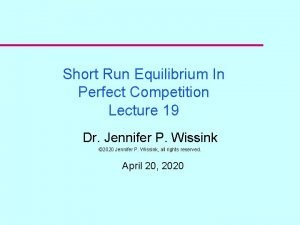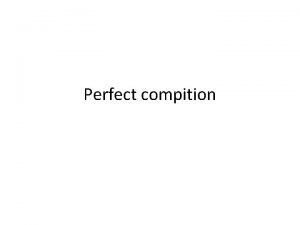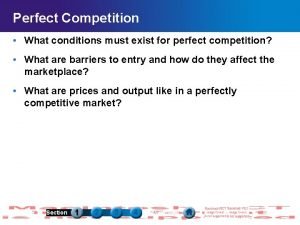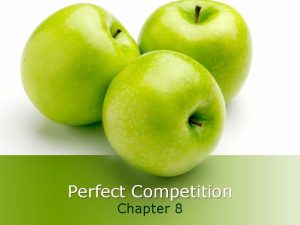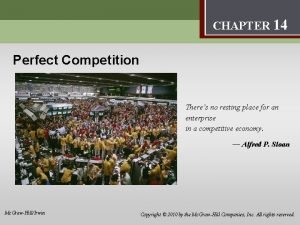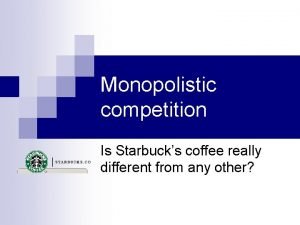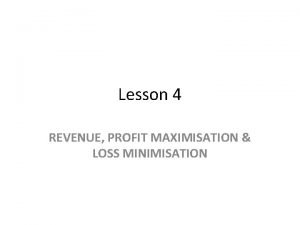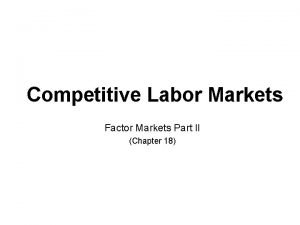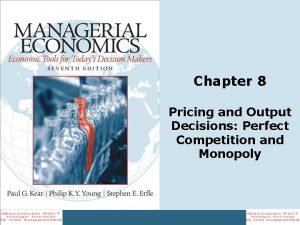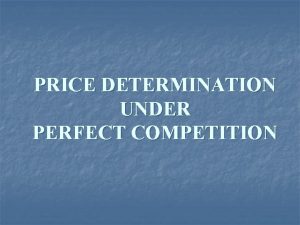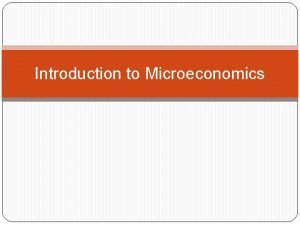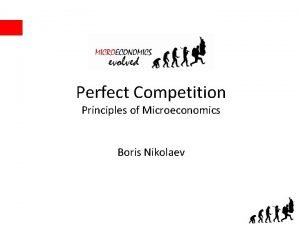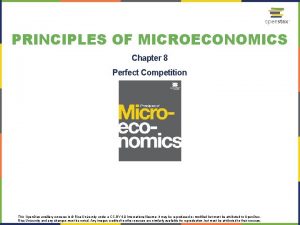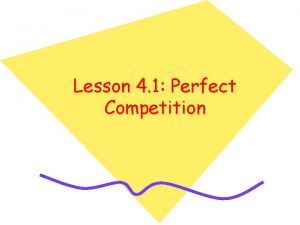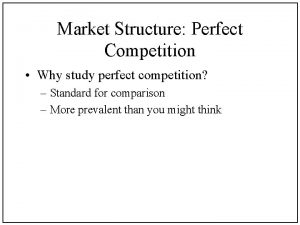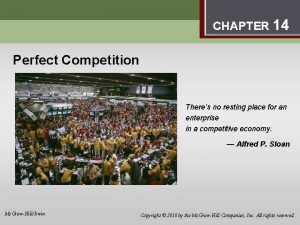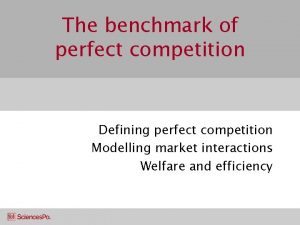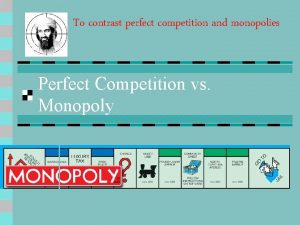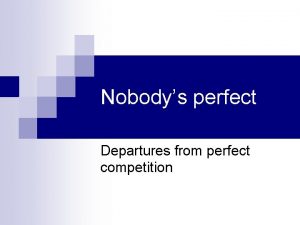Principles of Microeconomics Lecture 10 Perfect competition University























- Slides: 23

Principles of Microeconomics Lecture 10: Perfect competition University of Papua New Guinea

Lecture 10: Perfect competition Michael Cornish Overview • Markets: four basic categories • Perfect competition – Losses in the short run – Entry/exit of firms – Conclusions Slide 1 The University of Papua New Guinea

Lecture 10: Perfect competition Michael Cornish Markets: four basic categories Perfect competition Monopolistic competition Oligopoly Monopoly Many Few One! Identical Differentiated Identical or differentiated Unique Barriers to entry/exit None Low High Entry blocked Price taker / maker? Taker Maker • M Characteristic Number of firms Type of product Examples of • Rice industries • Wheat Slide 2 • Hairdressers • Restaurants • Banking • Letter delivery • Supermarkets • Tap water The University of Papua New Guinea

Lecture 10: Perfect competition Michael Cornish Characteristic Perfect competition Number of firms Type of product • The demand curve facing individual firms in a perfectly competitive market is horizontal – i. e. perfectly elastic Perfect competition Many Identical Barriers to entry/exit None Price taker / maker? Taker Examples of industries • Rice • Wheat • This does not change the market-level supply and demand analysis – I. e. , the demand curve facing the market is not flat! Slide 3 The University of Papua New Guinea

Lecture 10: Perfect competition Michael Cornish Perfect competition • Marginal revenue (MR): – The revenue generated from the additional (‘next’) unit sold • Average revenue (AR): – Total revenue ÷ quantity = TR = Average P x Q Q Q • In a perfectly competitive market: • Demand curve = P = MR = AR Slide 4 The University of Papua New Guinea

Lecture 10: Perfect competition Michael Cornish An example Number of bushels (Q) Market price per bushel ($P) Total revenue (TR) Average revenue (AR) Marginal revenue (MR) 0 $4 $0 - - 1 4 4 $4 $4 2 4 8 4 4 3 4 12 4 4 16 4 4 5 4 20 4 4 6 4 24 4 4 7 4 28 4 4 8 4 32 4 4 9 4 36 4 4 10 4 4 Slide 5 The University of Papua New Guinea

Lecture 10: Perfect competition Michael Cornish Perfect competition • Producers in a perfectly competitive market can sell as much produce as they want to at the same constant price • The profit-maximising level of output is: – Where the difference between total revenue and total cost is the greatest – Where MR = MC Slide 6 Note: The MR = MC rule applies for ALL market types The University of Papua New Guinea

Lecture 10: Perfect competition Michael Cornish An example Quantity Total cost (bushels)(Q) revenue (TR) (TC) Profit (TR – TC) Marginal revenue (MR) Marginal cost (MC) 0 $0 $1. 00 - - 1 4. 00 0. 00 $4. 00 $3. 00 2 8. 00 6. 00 2. 00 4. 00 2. 00 3 12. 00 7. 50 4. 00 1. 50 4 16. 00 9. 50 6. 50 4. 00. 2. 00 5 20. 00 12. 00 8. 00 4. 00 2. 50 6 24. 00 15. 00 9. 00 4. 00 3. 00 7 28. 00 19. 50 8. 50 4. 00 4. 50 8 32. 00 25. 50 6. 50 4. 00 6. 00 9 36. 00 32. 50 3. 50 4. 00 7. 00 10 40. 00 40. 50 - 0. 50 4. 00 8. 00 Slide 7 The University of Papua New Guinea

Lecture 10: Perfect competition Michael Cornish An example (cont. ) Slide 8 The University of Papua New Guinea

Lecture 10: Perfect competition Price (and cost) Michael Cornish Firm level analysis: Putting it all together… MC Total π = (P – ATC) x Q ATC P* 0 Slide 9 D = MR Q π-maximising level of output Quantity The University of Papua New Guinea

Lecture 10: Perfect competition Michael Cornish Perfect competition • Profits (π): – Where P > ATC: firm makes supranormal – Where P = ATC: firm makes normal π π – Where P < ATC: firm experiences losses • These apply in all markets! Slide 10 The University of Papua New Guinea

Lecture 10: Perfect competition Michael Cornish P = ATC = MC Price (and cost) MC Break-even point (Total π = 0) ATC D = MR P* 0 Slide 11 Q π-maximising level of output Quantity The University of Papua New Guinea

Lecture 10: Perfect competition Michael Cornish P < ATC Price (and cost) MC ATC Losses = (P – ATC) x Q D = MR P* 0 Slide 12 Q Loss minimising level of output Quantity The University of Papua New Guinea

Lecture 10: Perfect competition Michael Cornish Perfect competition: Losses in the short-run • In the short-run, a firm suffering losses has two choices: – Continue to produce – Stop production and shut down temporarily A note on sunk costs Sunk cost: A cost that has already been paid and cannot be recovered, and thus, logically, should not be considered in future decision-making A fixed cost is not necessarily a sunk cost! Slide 13 The University of Papua New Guinea

Lecture 10: Perfect competition Michael Cornish Perfect competition: Losses in the short-run • P > AVC – Even if a firm suffers losses, it should continue to operate as long as it can recover its variable costs • P = AVC – The firm is indifferent as to whether it operates or shuts down temporarily • P < AVC [‘Shutdown point’] – The minimum point on a firm’s average variable cost curve; if the price falls below this point, the firm shuts down production Slide 14 The University of Papua New Guinea

Lecture 10: Perfect competition Michael Cornish Illustrating the shutdown point Price (and cost) The supply curve for the firm in the short run MC ATC AVC The minimum price at which the firm will continue to produce PMIN Shutdown point 0 Slide 15 QSD Quantity The University of Papua New Guinea

Lecture 10: Perfect competition Michael Cornish Perfect competition: Entry / exit of firms • Where supranormal profits exist, new firms will enter the market => Supply => P, Q • Where losses persist, firms will exit the market => Supply => P, Q • Long-run equilibrium? – Normal economic profits! Remember, there are no significant barriers to entry/exit! Slide 16 The University of Papua New Guinea

Lecture 10: Perfect competition Michael Cornish Where supranormal profits exist… Slide 17 The University of Papua New Guinea

Lecture 10: Perfect competition Slide 18 Michael Cornish The University of Papua New Guinea

Lecture 10: Perfect competition Michael Cornish Where losses exist… Slide 19 The University of Papua New Guinea

Lecture 10: Perfect competition Slide 20 Michael Cornish The University of Papua New Guinea

Lecture 10: Perfect competition Michael Cornish In summary: Slide 21 The University of Papua New Guinea

Lecture 10: Perfect competition Michael Cornish Perfect competition: Conclusions • Productive efficiency? • Allocative efficiency? • Dynamic efficiency? Dynamic efficiency: The ability of firms to develop and adapt to change over time (especially re: technology) Sounds great! But unfortunately, few markets are perfectly competitive. . . Slide 22 The University of Papua New Guinea
 Lump sum subsidy
Lump sum subsidy Monopoly vs monopolistic competition
Monopoly vs monopolistic competition Perfect competition vs monopolistic competition
Perfect competition vs monopolistic competition Intermediate microeconomics lecture notes
Intermediate microeconomics lecture notes 22 rents
22 rents Market structures venn diagram
Market structures venn diagram 01:640:244 lecture notes - lecture 15: plat, idah, farad
01:640:244 lecture notes - lecture 15: plat, idah, farad Cortar present perfect
Cortar present perfect Perfect competition side by side graphs
Perfect competition side by side graphs Long run market supply curve
Long run market supply curve Perfect competition curve
Perfect competition curve Shut down point
Shut down point Monopoly conditions
Monopoly conditions Long run profit in perfect competition
Long run profit in perfect competition Perfect competition advantages
Perfect competition advantages Many sellers and many buyers
Many sellers and many buyers Shut down point
Shut down point Is starbucks an oligopoly
Is starbucks an oligopoly Pure competition advertising
Pure competition advertising Perfect competition examples pictures
Perfect competition examples pictures Barriers to entry for perfect competition
Barriers to entry for perfect competition Perfectly competitive firm profit maximization
Perfectly competitive firm profit maximization Factor market perfect competition
Factor market perfect competition Pricing and output decisions in perfect competition
Pricing and output decisions in perfect competition










